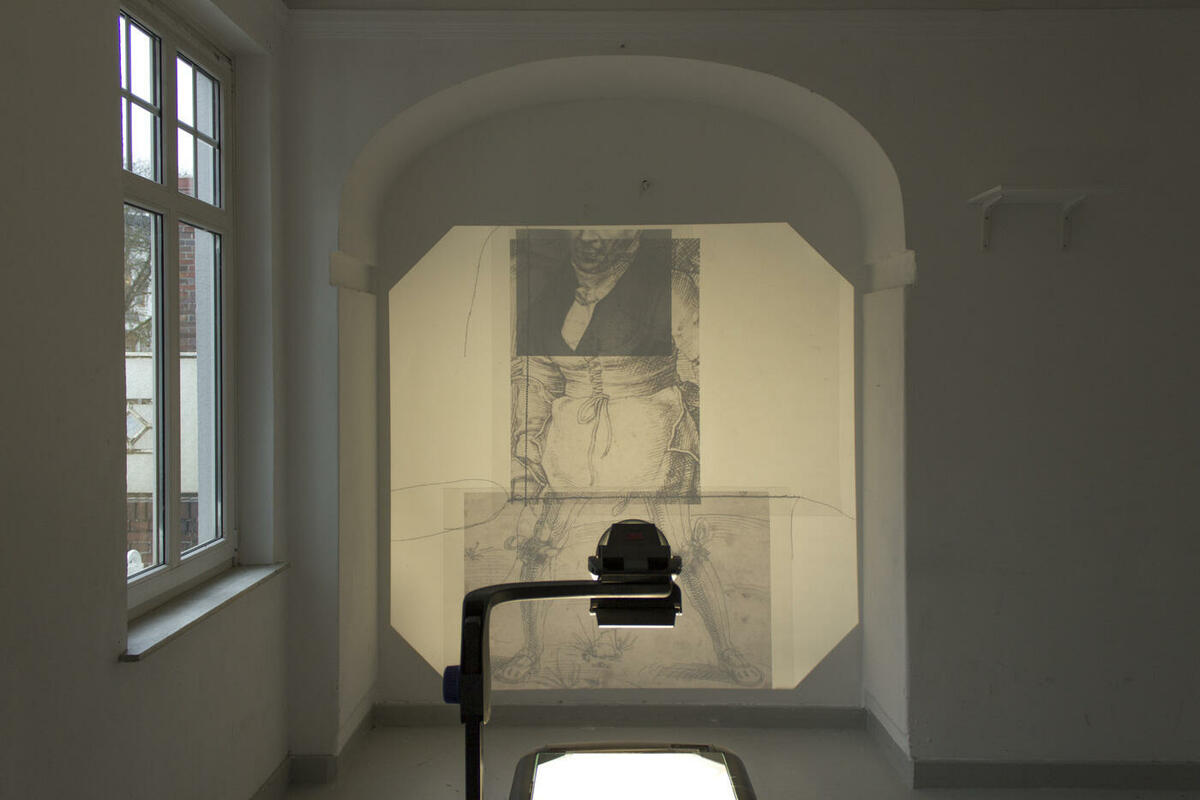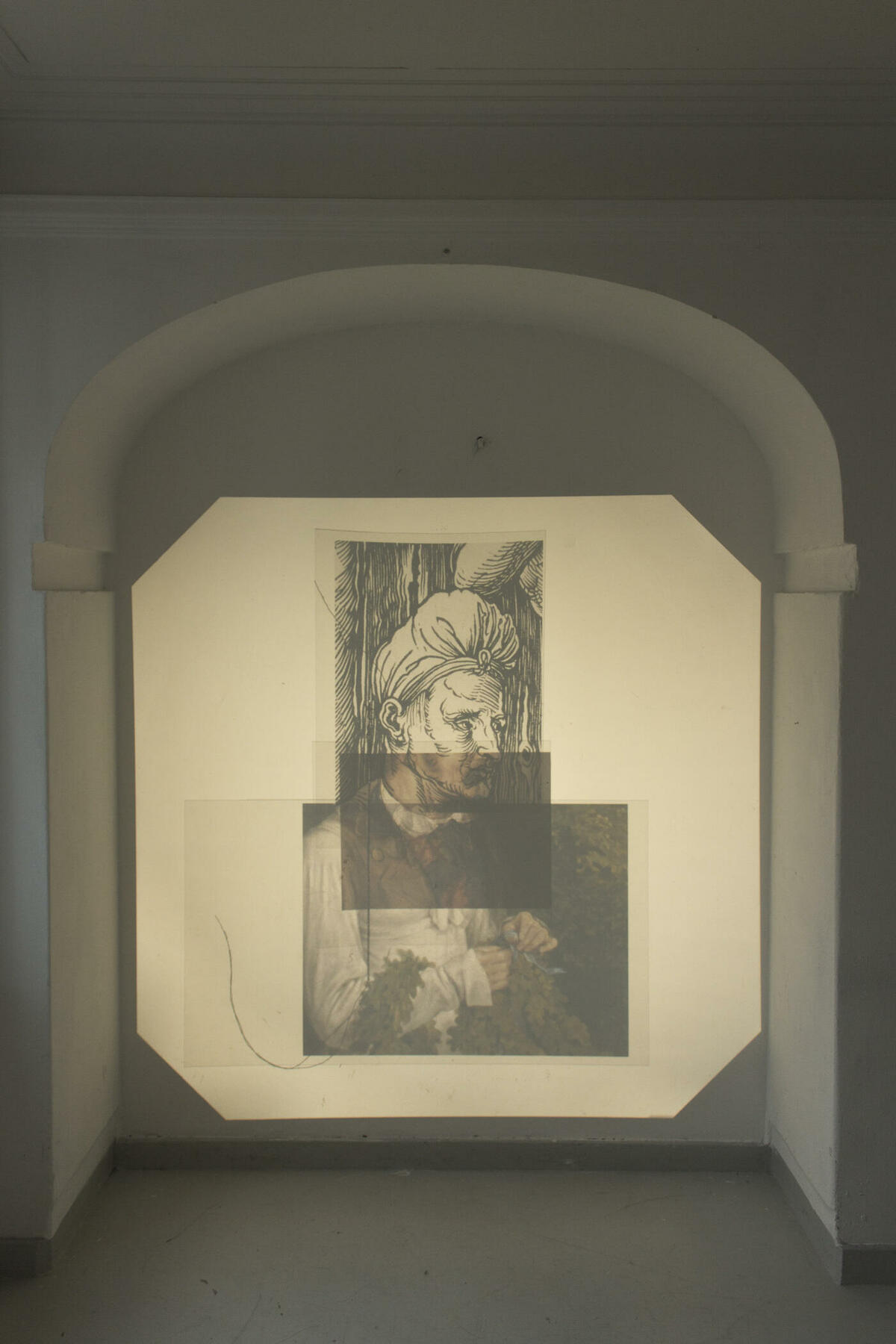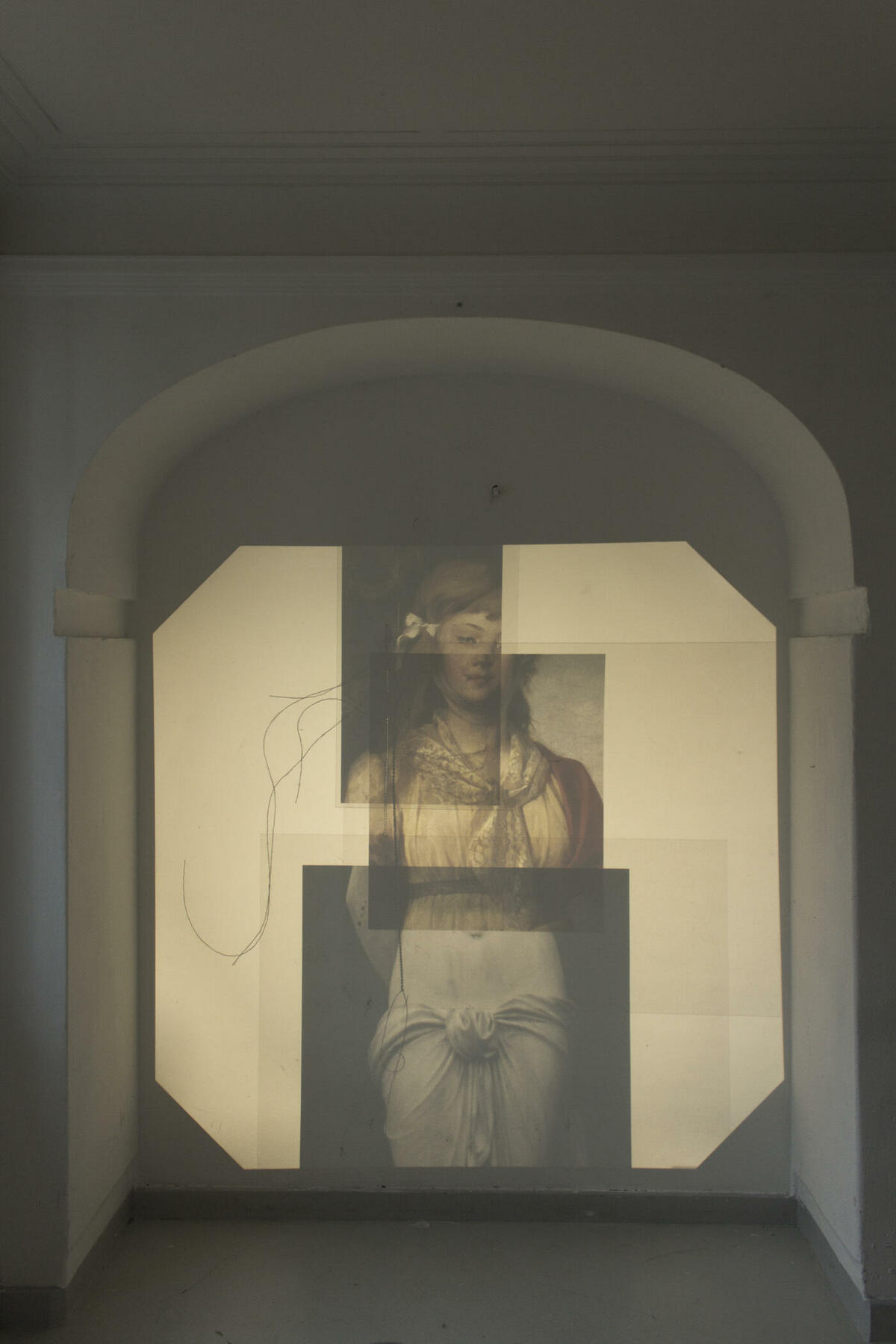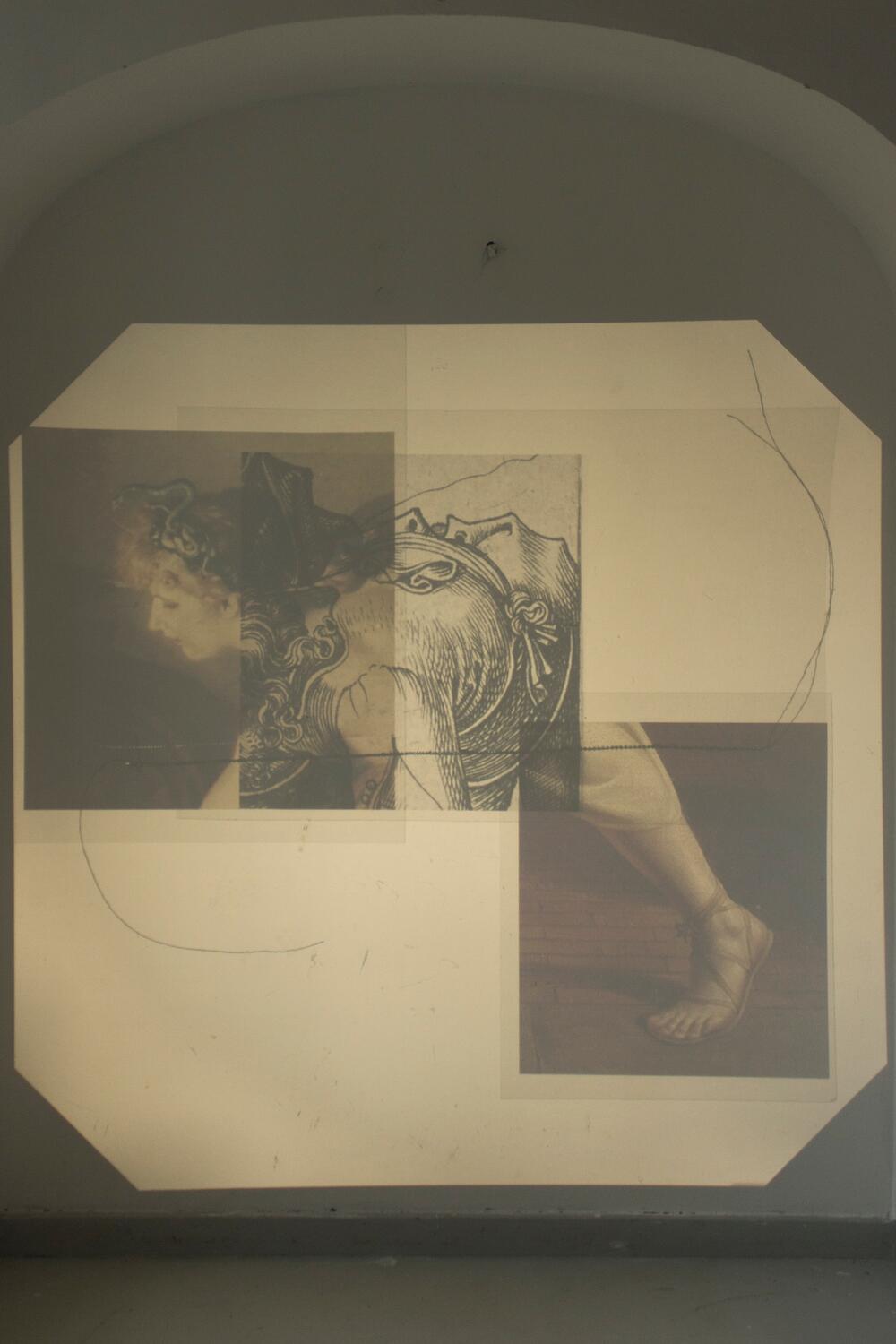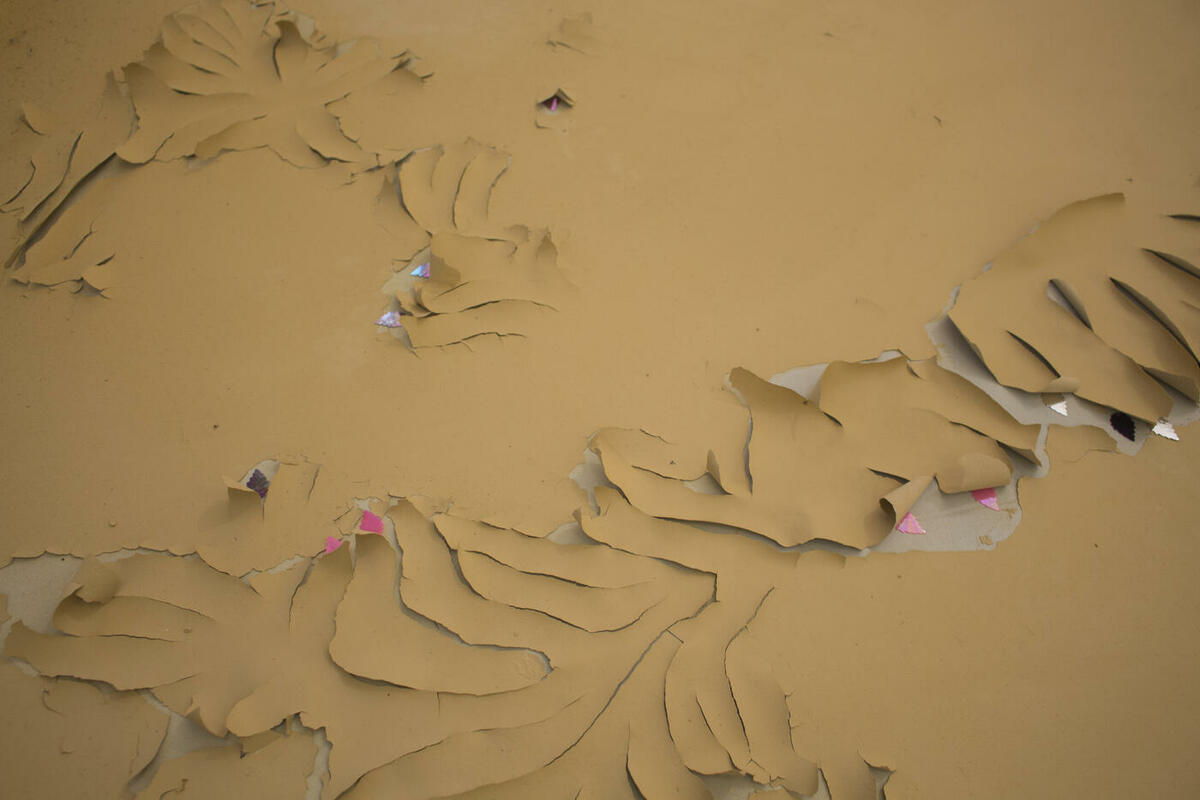Drawing from his component in The Dynamic Archive, Lucas Odahara worked further in the space of Circa 106, amending the knots of history present in paintings from museum collections. His inspiration comes form Mary, Untier of the Knots, who, within Marian devotion in South America, is believed to be able to untie small everyday problems and unresolved questions.
As museum visits are not possible at the moment, Lucas decided to use the online archive of Alte Nationalgalerie in Berlin and Kunsthalle Bremen. Through printed fragments of paintings depicting knots, he combines, reorganises and creates new bodies. Printed on transparent foil, these body parts are sawn together with a sewing machine.
With the visible stitches, Lucas emphasises the connection as well as the unruly movement of the thread contrasting the rigid structure of the cut out plastic. Shown with an overhead projector, the bodies that emerge, in almost life size proportions, question the way history is represented through the renaissance paintings. In a manner that is often used to teach art history, Lucas Odahara uses an overhead projector to present a body through history in a different way, paradoxically using the stitching of the machine to ‘untie the knots of history’.
Exploring the symbolism of a chain, Elburuz created a landscape in the space of Circa 106 which unfolds in different directions and fragments. Through the details and materials they choose, Elburuz opens the space where different materiality coexists. The mud invades through space, open in its form, inviting rather than closing. Through the cracks and openings, elements of glitter and scalable objects are revealed. In a subtle way, through its form and difference, the installation flows through the room creating a new space for many discourses.
The chains are depicted as fragments of the landscape that unite, rather than bound. Seen as an aesthetic object, in its various forms and applications, a chain becomes a playful part of the landscape in contrast to the guilt and punishment one would associate to these objects throughout history, as is often depicted in a Renaissance painting. Interested in the economy of guilt, Elburuz uses the golden chain to explore its various currencies and gives their own perspective. In the seeming drought of dry mud, Elburuz harvests the possibility of difference and a non-binary field of being, creating an almost magical aesthetic. As their version-component in The Dynamic Archive, so does the installation in Circa 106, explore the revenge of the queer in all its subtleties and variations.
Small interventions, such as changing the cable of the overhead projector, that Lucas used, to a golden cable that gets lost inside the dry mud on the ground, connect the two works in the space. The table on which Lucas positioned the overhead projector, Elburuz extended, leaving the space open in the middle. The table which is usually extended for a guest or extended family when they visit leaves the space for inclusion. At the same time, by leaving it open, Elburuz poses the question: is it ever truly possible to unite or will there always be an empty space waiting?
Lucas’s stitching, which is emphasized through the light of the overhead projector, resembles the chains and the tight bond a chain creates. Through the use of symbols of knots and chains, Lucas and Elburuz, in their own ways, tackle the depiction of the body through history and decontextualize the symbols through the relation of Untie - Unite.
-How do you think of @ Lucas knots and @ Elburuz chains in relation to the body and institution like a museum (Lucas) and religion (Elburuz)?
L: The way I think of knots in this work comes specifically from the Marian devotion the Untier, which is a metaphor for solving small everyday problems. I like this Marian devotion, so present in my family, because it turns all kinds of unsolved matters into a fastidious practice like that of untying – no matter what the problem is, it will ask for an active gesture, patient, and no grandiose move. I think this kind of practice could be applied to art institutions in the way they approach some of the questions they are faced with today. For instance, decolonizing a collection or gender politics in a museum most often do not require a grand gesture like a high budget exhibition on the topic. In fact this kind of blockbuster shows usually get on the way of real change. Significant work is made of clear smaller decisions in the way the institution functions internally. Equal gender payment, collection’s provenience research, people of colour in positions of power, these for me are the interesting knots, and they happen in the museum’s daily tasks.

When I searched for the knots in the paintings of the Kunsthalle Bremen and the Alte National Galerie in Berlin, they were all close to the body as they were mostly found in clothing – a knot has usually the proportions of the hands and it is meant to be easily handled. These seemingly big structural questions that art institutions face also lies very close to the body of their staff, in their everyday decision making. So why not focus on the attainable practical gestures I mentioned above, the same way we untie a knot?
E: Knots are somehow artificial but also there is an easiness to loosen them, in where chains are being forged to become one. It might be problematic to loosen a knot from a piece of cloth. A huge revelation might occur. However just to think about such a revelation has also an erotic quality. In that sense a secrecy level of a knot could be found in religion as well as in the art. Knots could bind relations like the chains. A fragment of a chain is also a forged fragment of a body that could be seen inflexible in compairement to a knot. Dogma and conventional wisdom use this characteristic mostly to manifest themes such as guilt/debt via punishment in some economies of religion.

-Could you elaborate on the tools and media you use in your practice?@ Lucas, in relation to structure and parts (teil) and materials and @Elburuz in relation to the landscapes and materials you work with.
L: I very often work with tiles in my practice, which pronunciation is so similar to the word ‘Teil’ in German meaning part or share. But tiling arrived in my work from a not exactly ‘beautiful’ place. Its history carries so much violence. They are the historical murals that covered walls in Brazil depicting a colonial history from the perspective of the coloniser. It is also a material that travelled the world following global economy and trade from the beginnings of global capitalism we see today, which paths often coincided with the slave trade. I see this material and technique as an ancient witness of so many world structures present today. But I also see a history of artists that crafted beautiful and hopeful images with it. And most of all, today I am interested in the potential of tiling for a reorganisation of how we picture these same violent histories.
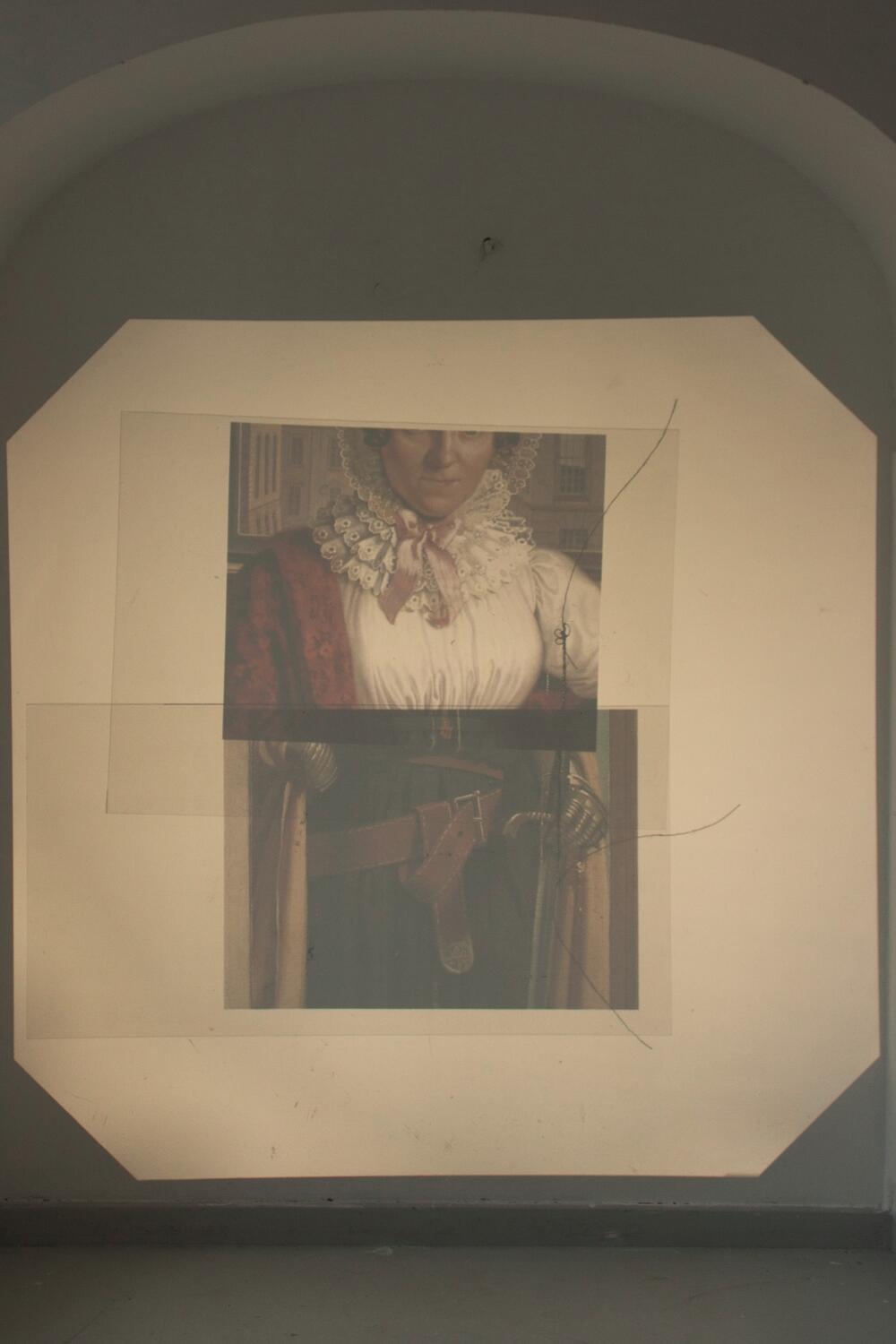
There has been across times different pursuits on rewriting or reimagining the past, as if time can be cleaned anew, as if it’s made of zero starts. And I feel like the idea of a complete revision of things is harmful no matter the intention. I am very interested in how we imagine or choose the histories of our presents, and tiling as a tool offered me a visual way to interrogate this. An image on a tiled surface must be reconsidered every now and then due to missing or broken tiles that must be replaced. It is an image in constant negotiation, where some pieces can be rethought, replaced without a complete revision or erasure of the entire picture. For the work at The Dynamic Archive, I used this same principle. So they are not static or finished images. They are a proposal that requires a future that includes negotiation.
E: I suppose working with landscape derived from a former theme which these cycles of work started with. At the beginning I have tried to understand a period of time which is repeatedly reminded through a dream. In this dream I have seen myself in a train which travels from my hometown to middle anatolia in midsummer. This was surely related with "kindliche Paradies". A yearning to go back to a very special time where everything could be possible. Also the relation of childhood and scaleable things followed with this landscape. In that landscape it was possible to see wheat fields and also repressed femininity. Therefore the materiality is related to the conventional connotation of "mädchenhaft" elements. Surprisingly it challenges the binary systems and also even testing the art-scene where an obsessive hand craftsmanship, cleanness, high valued materials are being applauded. In this terriority currencies are in a Queer exchange.

I felt like in terms of a landscape and maybe an agricultural landscape the connection between lucas´s united bodies. In those unifying moments I thought that I saw the peasant and the bourgeois came knotted together. This combination is also remarkable in terms of the table. Who brings the supper to this table? Who is being invited? Who are being knotted together maybe also sometimes forcibly. In the meantime this combination of the peasant and the bourgeois is on the top of this table. Those subjects are becoming one with the wall through their transparencies . The other participants are maybe forgotten for a long time. Nowadays in Queer_Now we experience that they are claiming their place to sit at this table or better said they transform the table for another kind of gathering. It also arrives from a non-artificial nature, it invades and brings the chains which causes a repellent gathering as guilt/debt are being thematized. I do not see this approach as an unpleasant act because as we see it has some qualities, it converts those (guilt/debt) currencies into admiring chains of fall which loosen themselves and create other flakes which shimmer between the cracks of earth.
-Through our talks, interesting points came up regarding the intention of the artist when creating his work and the outside interpretation of the work in relation to queer theories or queer art. In what way would you say the work you created in Circa 106 relates to the notion of queer(ness)?
L: My former art professor, Rosa Barba, gave me a book when I finished my studies titled Seeing is forgetting the name of the things one sees. It’s a book on Robert Irwin’s work. I think of this title every now and then, as I move between moments of completely agreeing with it and moments of rejecting and getting angry at it. It’s a sentence that puts so much importance into the senses and physical experiences in contrast to naming as the utmost example of abstraction. And that makes me angry, as I don’t think that language is detachable from physical experience. That being said, it’s hard for me to ignore the amount of naming that I experience growing up as a gay man, as a brown person in Europe, as a half Japanese in a Brazilian-Japanese community, etc. so imagining being seen without all these namings is really a recurrent dream.

I tell this, because I think that the interpretation of my work as being part of a queer practice is so much about naming something. And the same way that naming can be violent, it also deems necessary at times. Learning how to navigate between naming and being is for me currently the question I’m interested at. The work I made at Circa 106 opens seemingly hard things like a permanent museum collection into a space of negotiation, so I think some people would relate that to queerness? I honestly don’t think there is any fixed definition on what queerness mean, and that’s why it’s a naming that I’m so far in relative peace with. But I do hope, when the right conditions are set, that there is more being and less naming. Maybe being is forgetting the name of the things one is?
E: I guess in this cooperation, we do acknowledge a constant transformation from the digital versions and as well as in real space. This transformation is itself probably Queer. It changes, it derives, it invades. Surely we do need a reflection from the people who could examine and experience such an installation. In that exchange probably many Queer fragments are going to be intuitively murmured. I do not know exactly if it should be described who, what, when is Queer exactly, surely those temporalities exist but very quickly they do also transform themselves to other things. It is supposedly Queer if it could react with many Others in someway, in now. Then it is probably also not Queer in that moment as we describe it as Queer. I am having sweet troubles as I recall this word, it feels as if it is an evil-eye, "you-know-who", Jinxed already. It might be interesting to leave some knots as they are. Supposedly, those knots are able to tie themselves new.



